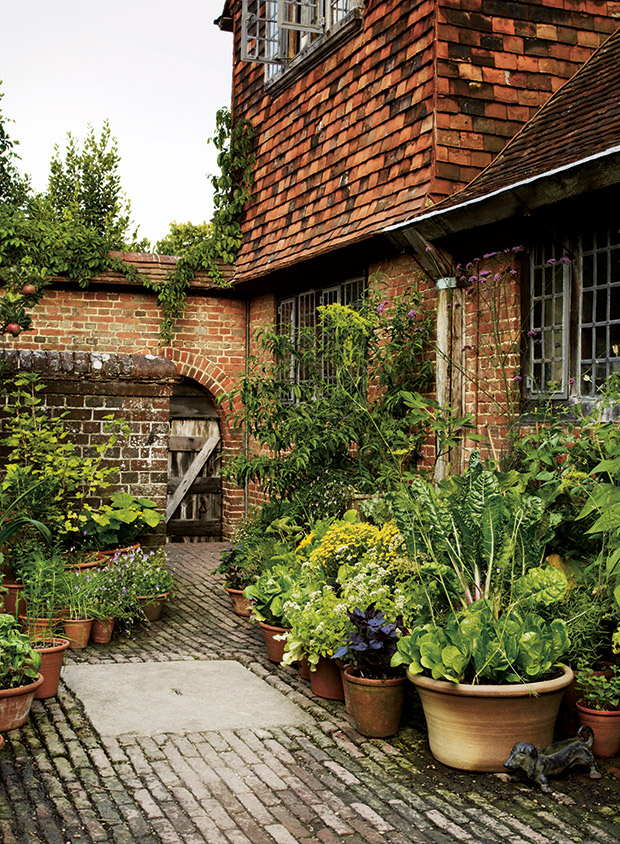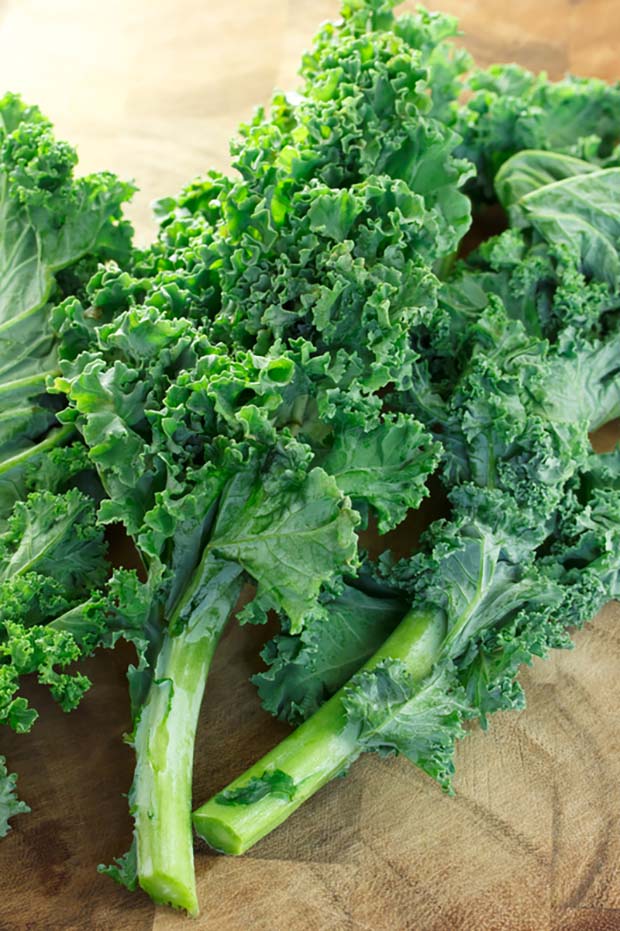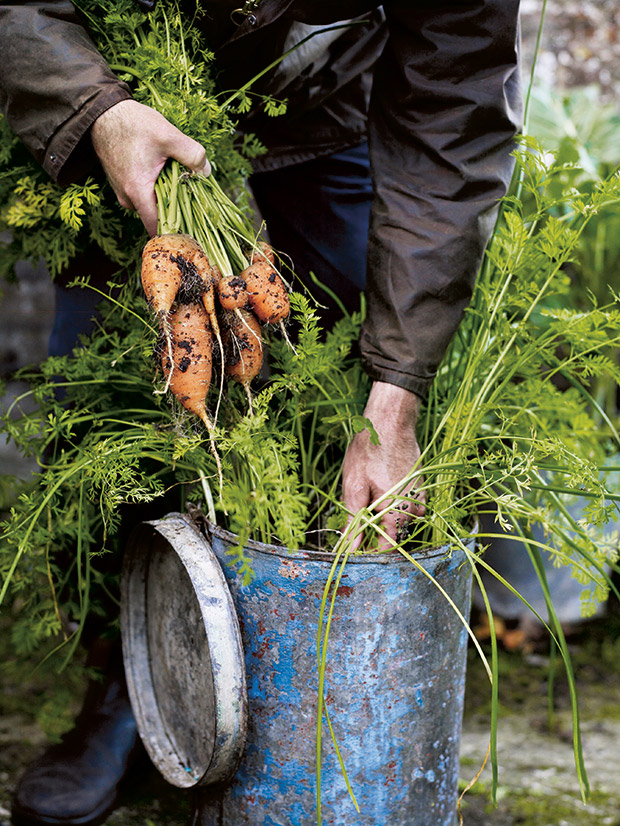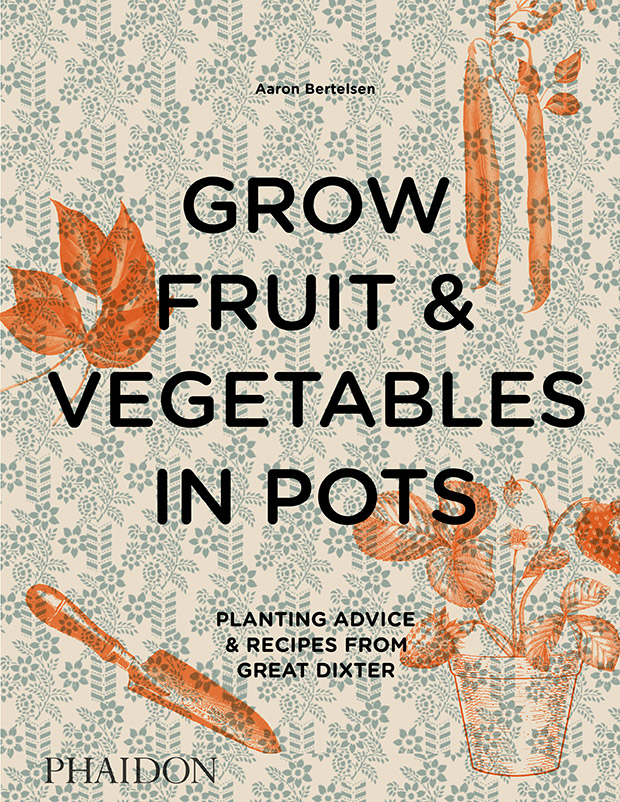4 hearty winter vegetables to grow in pots (and how to do it right)

Some well-placed pots can bring a cold-weather harvest to any small garden. The gardener and cook at the world famous Great Dixter garden in East Sussex shares his favourites.
Extract from Grow Fruit & Vegetables in Pots by Aaron Bertelsen Photos: Andrew Montgomery
1. Silverbeet
When space is tight, you sometimes have to choose which vegetables are worth growing and which are not. Have no doubt – silverbeet (swiss chard) is definitely worth growing. For one thing, this annual plant is incredibly robust and crops the whole year round, making it amazing value for money. You can simply cut the leaves as you need them, and they will grow back.
Another good reason for growing silverbeet is that it wilts quite quickly after picking, so the leaves in the shops (if you can find them at all) tend to look rather sad. Then there is its beauty. With its shiny crinkled leaves and strikingly coloured, almost fluorescent stems, it makes an exotic adornment to any garden.
Choose a big pot, as silverbeet is a sturdy plant and vigorous grower, and water at least every other day to keep it looking lush. Of course, the main reason for growing it is that it is tasty and extremely useful in the kitchen: try it in tarts and soups, use the stems as an alternative to cauliflower in a cheese sauce, or serve it as a green leafy vegetable.
The closely related perpetual spinach shares many of chard’s attributes. While it is less glamorous, it is another brilliant year-round performer.
Favourite varieties: There seem to be new varieties of chard coming onto the market all the time. I’m currently enjoying a flirtation with ‘Peppermint’, which has wonderful pink and white striped stems like candy canes. But the one I come back to year after year is ‘Flamingo’. The combination of cerise stems and deep green, shiny leaves is irresistible.
Key dates: Sow new seeds in spring, preferably before the previous year’s crop runs to seed to ensure a continuous supply. I start mine either inside or under glass in a 10-cm/4-inch pot, then prick out the seedlings into their final position. You can make life easier for yourself by sowing the seeds direct – just cover with some fleece to get them started. You will still get a good crop; it will just be a little later than if you were starting under cover.
Common problems: While chard is generally hardy it will suffer in a properly cold winter. In this case, cover it and move it to a sheltered spot. Apart from that, overcrowding is the main thing to look out for, as silverbeet is rather prone to mildew and also very appealing to slugs and snails. The best way to offset these problems is to keep picking so that the plants can’t grow too congested. Regular picking will also help to stop it from running to seed.
2. Kale

In recent years kale has become a ‘fashionable’ vegetable, widely promoted by health and fitness enthusiasts. In fact, people with good sense – and good taste – have been eating kale for years. Not only is it full of nutrients, it is also a reliable source of fresh greens when there is little else about.
However, one thing that is new – and most welcome, in my view – is the proliferation of new varieties in all sorts of shapes and colours. These are perfect for adding interest to the container garden, especially in winter. Try planting a dark red or purple variety against the glaucous foliage of leeks, for example. Choose a generous pot, as this annual is a sturdy, long-lived vegetable, but not the thirstiest of crops; a good soaking twice a week will be enough.
I find kale incredibly useful in the kitchen, as an ingredient in a winter smoothie, a side dish or a healthy addition to soups, such as this Oven-baked Lentil Soup with Greens.
It also makes the most brilliantly moreish kale crisps (chips). Just coarsely chop a handful of leaves, massage in some olive oil and salt, a squeeze of lemon juice and a little cayenne pepper if desired, then lay the leaves flat on a baking sheet and bake in an oven preheated to 180°C/350°F/Gas Mark 4 for 10–15 minutes until crisp and lightly browned. Perfect with an aperitif while you are making the supper.
Favourite varieties: With so many varieties on the market now, it is difficult to choose, but I think my top three for their combination of flavour and colour would have to be ‘Redbor’, ‘White Russian’ – which is actually bright green with white ribs – and ‘Red Russian’. ‘Cavolo Nero’ is beautiful too, with its deeply crinkled, nearly black leaves.
Key dates: I like to grow kale as a winter crop: the cold improves the flavour and also kills off the eggs of cabbage white butterflies, which can be a real nuisance when they hatch. I find the butterflies that do survive are less attracted to curly kale varieties, like the three I have selected.
I start the seed off in pots in late spring or early summer, then prick them out into their final position once they are about 5 cm/2 inches tall. Leave 10–15 cm/4–6 inches between the plants. The aim is to avoid the pests, but still give them a long enough growing season to reach a decent size before the cold weather hits and checks their growth.
Kale will happily survive most UK winters, but in a colder climate move pots to a sheltered position and use fleece for protection overnight, and even during the day if conditions are very harsh. Just remember to lift the fleece off when you can so air can circulate.
Common problems: Pigeons can be a problem (see page 233), but are less likely to bother plants close to the house. Otherwise, the main enemy is the cabbage white butterfly. Try growing curly varieties to deter it, or cover the plants with a fine mesh. I always prefer to use a physical barrier than resort to chemicals.
3. Carrots

It was a lady who came to one of my vegetable talks who first told me about growing carrots in pots. She said that she did it to outwit the carrot fly, which operate at ground level, so if you grow your carrots higher up, they should escape. It works brilliantly. Another great advantage with container growing is that you can tailor the environment to the crop.
Carrots like it gritty, so I add some sharp sand to the mix – about one part sand to ten parts compost (potting soil). Tall, slender ‘long Tom’ pots are ideal. Being closer to the house, your carrots will be less exposed to the elements, and you can easily protect them on cold nights with a bit of hessian (burlap) to stop the soilfreezing so that they are easy to harvest. I love carrots in all their different incarnations – slender, young and fresh in the summer, bigger and sweeter in the winter once the cold weather has started to turn the starches to sugar.
Carrots are best sown direct as they don’t like root disturbance. You can buy special tape with the seeds correctly spaced out, but I prefer to sow from the packet, sprinkling them as thinly as I can. Inevitably, they will need to be thinned out further – initially to about 2.5 cm/1 inch apart, then even wider as the carrots grow bigger – but I look on this as a bonus.
Each time you do it, you are rewarded with a handful of baby carrots to put in a salad, dip into hummus or enjoy just as they are. Water thoroughly twice a week for plump, tender roots. If you have never tasted home-grown carrots before, you are in for a treat.
Favourite varieties: ‘Early Nantes’ has great flavour and I grow it successfully year after year. ‘Danvers’ is another good option, as it grows well in all soils, produces quite short carrots and has really good flavour. But perhaps the best all-rounder is ‘Chantenay Red Cored’, as it has excellent flavour, is so easy to grow and produces short, wide carrots.
Key dates: You can start sowing carrots in early to mid-spring and keep going right the way through to late summer to ensure a succession. Just keep popping more seeds into the spaces where you have harvested, or interplant them with other crops – remembering, of course, that they will need a tall pot to develop properly.
Spring onions (scallions) would be the perfect partner, as the smell will keep carrot fly at bay. My preference is to sow carrots in late summer because the ensuing cold weather makes them sweeter, the carrot fly have flown away, and it is a wonderful crop to have when there is little else around.
Common problems: Carrot fly is the number one problem. Using tall pots helps to keep them at bay, as does growing chives or spring onions (scallions) around the edge or nearby – carrot fly hate the strong smell. Carrots will also struggle in a soil that is too rich, or contains lumps of organic matter that haven’t broken down. Use a good, soil based compost and add some sand.
4. Beetroot
For me, beetroot is one of the greatest and most versatile of all vegetables. I love to use the greens as well as the roots. The young leaves are great in a salad, good simply boiled as a green vegetable, and delicious in a tart too. Even when the plants start to run to seed in the spring, they still make good eating, seeds and all.
They will grow happily in a 30-cm/12-inch pot, will tolerate partial shade and their dramatic foliage will add a great deal of visual interest to your container garden, particularly if you interplant them with something contrasting, such as bright green lettuce.
Have I said enough yet to convince you? If not, let me add that beetroot are very easy to grow provided you give the root enough space to develop. Remember, each one will ultimately be about the size of a tennis ball. You can sow direct, then thin them out as the young plants start to develop.
Don’t forget to eat the thinnings – they are delicious. One final plus: I have never found any need to feed them, provided they are in good soil-based compost (potting soil).
Favourite varieties: ‘Detroit’, with its rich, deep flavour, retains its top position on my list of favourites. ‘Boltardy’ is a great choice for growing in pots, and lives up to its name, being noticeably slower to bolt than other varieties.
Key dates: Sow seed in early spring. Cover the pot with fleece to get the seed moving. If you have any leftover plants by the winter, they will also benefit from being covered if the weather turns very cold.
Common problems: The only real problem you are likely to encounter is bolting, so be sure to give the plants plenty of water in warm, dry weather. A good soaking every three or four days should be enough.
Extracted from Grow Fruit & Vegetables in Pots by Aaron Bertelsen, Phaidon, RRP AUD$49.95. Photography © Andrew Montgomery, 2019
About the author
Aaron Bertelsen’s love of gardening dates back to his childhood in New Zealand where he worked with his grandfather in his vegetable garden. In 1996, he volunteered in the garden at Great Dixter, home of celebrated gardener and writer Christopher Lloyd (1921-2006), whose vision established its extensive gardens as a place of pilgrimage for horticulturalists from around
the world. Bertelsen subsequently studied horticulture at Kew Gardens, and spent 2 years at the Jerusalem Botanical Gardens in Israel. Bertelsen returned to Great Dixter in 2005, becoming the vegetable gardener and cook in 2007. He is regularly invited to speak about gardening at events worldwide and published his first book The Great Dixter Cookbook: Recipes from an English Garden with Phaidon in 2017.
READ MORE


